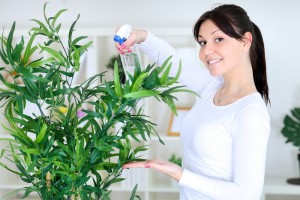 You know you’re not ready for kids or even a pet, but you’re fairly confident you can care for a plant. Fairly.
You know you’re not ready for kids or even a pet, but you’re fairly confident you can care for a plant. Fairly.
Plants are living things as well; however, they’re often forgotten since they don’t beg for a walk. If you’re considering indoor plants, here are five tips to keep those babies healthy:
1. Procure the Right Plant
Keeping your plant healthy starts before you even bring it home. Don’t begin with a brown thumb. Choose a plant designed for the indoors. The best types of indoor plants are low maintenance. Better Homes and Gardens names 24 easy household plants. They include everything from small pine trees to Chinese evergreens, making it easy to find a plant that suits your lifestyle and decor.
2. Find Your Plant a Home
When you bring your plant home, take care in finding it a permanent spot. According to Apartment Therapy, you’re shocking your plant if you’re constantly moving it. Plants, just like people, acclimate to their environment. Even subtle shifts in light and temperature can upset its balance.
When selecting a home for your plant, don’t choose tables — these areas are generally the first cleared when making room for food or work. Consider creating a space specifically for your plant, such as a shelf, where you’re likely to keep it there permanently.
3. Let in the Light
Although each plant is different, they commonly all need light. Ask your local nursery just how much light yours will need. Some plants are great indoors because they thrive in low lighting. Succulents are great low light plants. How Stuff Works explains the different types of lighting conditions and how plants thrive in them.
4. Prune It
This is a basic part of plant upkeep that’s often forgotten. According to About.com, “plants should typically be pruned in the beginning of the growth season or just after they have finished flowering.” Many people have the best intentions when it comes to indoor greenery; however, in the end, a shelf plant is likely to collect dust.
Make a point to visit your plant at least once a week, aside from watering. This will help you pay attention to your plant’s growth patterns, making it easy to identify when it’s time to prune.
5. Add Water
Watering is the least forgotten part of plant care. However, your watering habits may cause more harm than help. Here are several signs your plant is over or under-watered:
- Limp Leaves. This is a sign of either over or under-watering. Leaves of both water patterns will brown; however, under-watered leaves are typically crispy.
- Dry Soil. This is easily a symptom of under-watering. Touch the soil several times a week to make sure the water levels are correct.
- Root Rot. This is a result of over-watering. Fungus can accumulate in your plant’s roots due to damp conditions.
Now that you have the proper tools for indoor gardening, it’s time to find your favorite plant. What indoor plants have you had the best luck with? Share your thoughts in the comments below.

